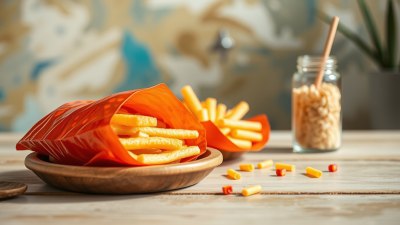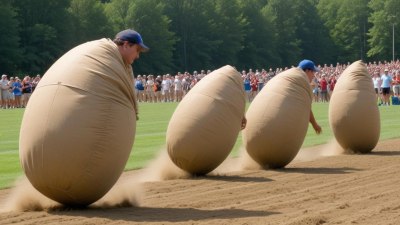How Heatwaves Turn Snacks Into Survival Gear at Work
Discover how heatwaves impact workplace snacking habits, transforming simple treats into essential survival tools for comfort and energy.

Image created with Flux Schnell
Heatwaves can dramatically alter our daily routines, especially when it comes to how we eat and stay energized at work. As temperatures soar, the usual snacks we rely on undergo a transformation, becoming vital tools that help us endure the sweltering conditions while maintaining productivity. Understanding this shift not only sheds light on human adaptability but also opens doors to smarter workplace nutrition during extreme heat.
Understanding Heatwaves and Their Impact on the Workplace
Heatwaves are prolonged periods of excessively hot weather, often accompanied by high humidity levels. When workplaces lack adequate cooling systems or when employees work outdoors, these conditions can lead to discomfort, reduced concentration, and even heat-related illnesses. The body's need to regulate its temperature increases energy expenditure, making nutrition and hydration more critical than ever.
In such scenarios, ordinary snacks become more than just a mid-morning or afternoon indulgence. They serve multiple roles: replenishing electrolytes, providing quick energy, and aiding hydration. Snacks that are effective in usual circumstances might not serve the same purpose during a heatwave. For instance, high-sugar, heavy snacks may increase thirst and fatigue, while select fruits or foods with higher water content can offer cooling effects.
The Science Behind Snacks and Heat Management
Human bodies cool primarily through sweating, which requires water and electrolytes like sodium, potassium, and magnesium. When the body sweats in response to heat, these electrolytes are lost along with fluids, creating an increased demand for replenishment. If not adequately addressed, this can lead to dehydration, muscle cramps, and heat exhaustion.
Snacks that help maintain electrolyte balance become crucial during heatwaves. Foods rich in potassium and magnesium, for example, are beneficial. Bananas, coconut water, watermelon, and nuts can provide these nutrients, helping to stabilize internal body functions and enhance endurance during extreme heat.
Moreover, snacks with a high glycemic index can quickly boost energy, which is necessary as heat stress can lead to fatigue. However, excessive sugar intake should be avoided as it might exacerbate dehydration by increasing thirst or causing blood sugar spikes followed by crashes.
Evolution of Snacking Habits in Response to Heatwaves
Traditionally, workplace snacks often include processed bars, chips, cookies, and caffeinated beverages. While these items offer convenience and taste, they might not be the best allies during heatwaves. Increased temperatures encourage a shift toward lighter, more hydrating options.
Employees facing heat stress at work have gradually adopted fruits such as watermelon slices, grapes, and citrus fruits for their water content and refreshing taste. Hydrating snacks not only provide calories but also ease the burden on the body's cooling mechanisms. Yogurt-based snacks or frozen fruit pops have also gained popularity as tasty ways to maintain hydration and energy.
The role of beverages in concert with snacks cannot be overlooked. Herbal teas, infused water, and electrolyte-rich drinks complement snack choices, supporting hydration and preventing electrolyte imbalances.
Creative Snack Strategies for Heatwave Survival at Work
To equip employees for heatwaves, workplaces and individuals have innovated creative snacking strategies. Portable coolers enable employees to bring chilled, hydrating snacks to their desks. Meal prepping with frozen fruits, chilled salads, and nut mixes enriched with dried fruits and seeds are common strategies.
Incorporating snacks that double as cooling agents is a smart way to address multiple needs at once. For example, cucumber slices sprinkled with a pinch of salt provide water, electrolytes, and a satisfying crunch. Similarly, citrus fruit segments not only hydrate but also offer a vitamin C boost that supports overall health during times of stress.
Psychological Benefits of Proper Snacking During Heatwaves
Beyond the physical impacts, heat stress influences mood and cognitive focus. Proper snacking can mitigate sun-induced irritability and fatigue. The act of consuming cool, refreshing snacks can offer an instant sensory relief, improving morale and concentration.
Selecting snacks that release energy steadily, rather than causing sugar spikes, helps maintain mental clarity. Snacks high in complex carbohydrates, fiber, and moderate protein support sustained energy levels. In this sense, heatwave-appropriate snacking is not only a nutritional intervention but a cognitive aid.
The Role of Employers in Supporting Healthy Snack Choices
Workplaces play a pivotal role in fostering environments conducive to well-being during heatwaves. Providing access to water stations, refrigerators, and shaded rest areas encourages healthier snacking and hydration habits. Some employers supply electrolyte drinks or fresh fruit baskets during peak temperature periods to support employees.
Education on heatwave nutrition is also crucial. Informing staff about the benefits of certain snacks and the risks associated with inadequate hydration can empower healthier choices. Employers who incorporate these considerations are likely to see improved employee satisfaction, reduced absenteeism, and enhanced productivity during heat stress.
Technology and Innovation in Heatwave Snacking
Modern technology aids in creating snacks tailored to withstand heatwaves. Packaging innovations help preserve freshness and coolness, while novel formulations enrich foods with electrolytes without excessive sugar. Smart vending machines stocked with temperature-sensitive items and apps recommending nutritious snacks based on ambient temperature are emerging trends.
Moreover, meal delivery services often include heatwave-friendly options, targeting workplace clients. These innovations ensure that even in the absence of personal preparation, employees have access to snacks conducive to survival and performance during extreme heat.
Global Perspectives: How Different Cultures Adapt Their Snacks During Heatwaves
Heatwaves are a global phenomenon, and cultures worldwide have developed unique snacking habits to cope. In Mediterranean countries, chilled salads with olives and feta offer hydration and electrolytes. In Japan, onigiri (rice balls) and chilled green tea serve as portable cooling snacks.
India's traditional buttermilk (chaas) combined with light snacks helps combat heat stress through hydration and electrolyte replacement. Southeast Asian countries often include coconut-based snacks or fresh fruits like lychee and mango, prized for their hydrating properties.
These culturally specific snacks exemplify how heatwave survival strategies are intertwined with local tastes, availability, and traditions, yet the underlying principles remain universal: hydration, electrolyte balance, and sustained energy.
Practical Tips for Choosing and Preparing Snacks During Heatwaves
When preparing snacks for hot workdays, prioritize items with high water content, natural electrolytes, and moderate energy density. Fresh fruits such as berries, oranges, and melons should be front runners. Pair these with a source of protein or healthy fats, like nuts or yogurt, to prolong satiety and steady energy release.
Avoid salty processed snacks, as excessive salt can lead to dehydration, particularly if not accompanied by adequate water intake. Similarly, deep-fried or heavily spiced foods might increase body temperature or induce discomfort.
Preparation includes using insulated containers or ice packs to keep snacks cool. Portioning snacks to allow frequent small intakes helps maintain energy without overwhelming digestion, which can be sluggish in heat.
Leveraging Workplace Culture to Encourage Healthy Snacking in Heatwaves
Promoting a culture that encourages mindful snacking and hydration during heatwaves can be transformative. Initiatives such as snack-sharing events featuring hydrating foods, water challenges, or reminders about electrolyte replenishment increase awareness and participation.
Leadership can model behaviors by choosing appropriate snacks during meetings or breaks and acknowledging the importance of adapting habits to heat conditions. Peer support can make a significant difference in overcoming barriers to change and fostering adaptive behaviors.
Addressing Challenges and Barriers to Effective Snacking During Extreme Heat
Despite the benefits, several challenges exist in adopting heatwave-appropriate snacking. Accessibility to fresh, hydrating snacks might be limited by cost, availability, or infrastructure such as refrigeration.
Some workers may have dietary restrictions or preferences that complicate snack choices. Additionally, habitual snacking patterns and cravings for comfort foods can conflict with optimal heatwave nutrition strategies.
Employers and employees need to collaborate to identify feasible solutions, such as bulk purchasing of fresh fruits, providing subsidies, or developing tailored snack options that consider diversity and inclusivity.
Monitoring and Evaluating the Impact of Snack Choices During Heatwaves
Collecting data on employee health, hydration status, and productivity during heatwaves can offer valuable insights. Surveys and feedback regarding snack preferences and perceived benefits help refine workplace nutrition programs.
Tracking absenteeism and incidents of heat exhaustion alongside snack initiatives can demonstrate correlations, supporting evidence-based adjustments. In this way, snacking strategies evolve from anecdotal recommendations to structured components of occupational health planning.
Future Directions
Recognizing that climate patterns predict increasing frequency and intensity of heatwaves, workplaces must develop sustainable snack solutions tailored to these conditions. Integrating heatwave-specific nutrition education, snack provision, and hydration monitoring into wellness programs forms a comprehensive approach.
Collaboration with nutritionists, health professionals, and climate scientists can yield innovative interventions. Ultimately, building resilience against heat stress through adaptive snacking is a proactive step towards safeguarding workforce well-being in a warming world.











